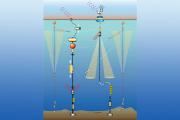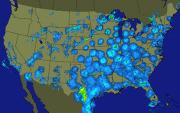Radio Program
Our regular Science and the SeaTM radio program presents marine science topics in an engaging two-minute story format. Our script writers gather ideas for the radio program from the University of Texas Marine Science Institute's researchers and from our very popular college class, Introduction to Oceanography, which we teach to hundreds of non-science majors at The University of Texas at Austin every year. Our radio programs are distributed at to commercial and public radio stations across the country.
Astronomers have been building observatories on mountaintops for decades. Lifting their telescopes above most of Earth’s murky atmosphere provides a clearer view of the stars.
Marine scientists are starting to build observatories to see through the murkiness as well — packages of instruments to probe the unseen depths of the oceans. A network of them is taking shape now, with many of the instruments coming online in the next couple of years.
Every state has a long list of official icons. The official aircraft of New Mexico, for example, is the hot air balloon, while in Hawaii, the official sport is outrigger canoe paddling.
Many coastal states also have an official state shell. New York has the beautiful bay scallop, while Mississippi and Virginia have the un-beautiful but economically important oyster. And in Texas it’s the lightning whelk — a long, tapered shell that opens on the left side, not the right.
Fishermen are usually trying to find ways to get fish to take the bait. When it comes to sharks, though, they’re trying to find ways to get them to leave the bait alone. And one strategy seems to have the potential to keep the sharks away: using metals with special magnetic properties.
Many species of sharks are endangered. In part, that’s because they’re common “bycatch.” They’re not the intended catch, but they’ll take just about any bait that’s put in front of them, so they get caught anyway. Millions of sharks are taken as bycatch each year.
If you stand with outstretched arms, it likely means you’re about to give somebody a hug. But it could also mean that you’re showing them the length of a fathom — a unit that’s been used to measure the depth of the sea for centuries. It’s one of several measurements developed for maritime use that are still around today.
It sounds like the start of a bad joke: What do an airplane wing and shark skin have in common? But a recent study suggests there’s a serious answer. Both of them provide a type of “lift” — one to get an airplane off the ground, the other to increase the shark’s speed.
A shark’s skin is covered with tiny scales, called denticles. Grooves in these scales channel water around the shark, reducing drag and increasing its speed and agility.
Survival is all about change. Species that can adapt to changing conditions will live on, while those that can’t are doomed. That’s why a study released a couple of years ago may be good news for olive ridley sea turtles in the eastern Pacific Ocean. The study showed that the turtles go with the flow — they aren’t stuck in rigid patterns. In a world where the climate is changing in a hurry, that could help ensure the turtles’ survival.
Every spring, millions of visitors flock to the coasts of Texas and Louisiana. They gorge themselves for a few days before many of them head north — often all the way to Canada.
These visitors are birds — dozens of species that cross the Gulf of Mexico to reach their summer breeding grounds. And scientists and birdwatchers alike get early notice of the arrivals from radar — the same stations that are used to track the weather.
For the most part, the coastal regions of Texas and Louisiana are flat and featureless. The coastal plains slope gently upward from the Gulf of Mexico, with few hills and canyons to break up the flat terrain. And that trend continues far out into the gulf as well.
About a hundred miles offshore, though, the contours begin to change dramatically. Maps compiled from decades of measurements show hills, ridges, and canyons that make the Gulf floor look more like the Badlands of South Dakota than the Great Plains.
Humans aren’t the only creatures that move around the globe in a hurry. Many species of fish do, too. One indication of just how quickly they move came after the nuclear accident in Japan. Within months, fish with high concentrations of radioactive particles were showing up in the waters off the coast of California.
That grilled red snapper at your favorite seafood restaurant may be just what it’s supposed to be — a tasty fish caught in the Atlantic or Gulf waters of the United States. On the other hand, there’s a good chance it’s rockfish, tilapia, or cod. There’s also a good chance that anything labeled “grouper” is really imported catfish. And monkfish could be a potentially dangerous pufferfish.




